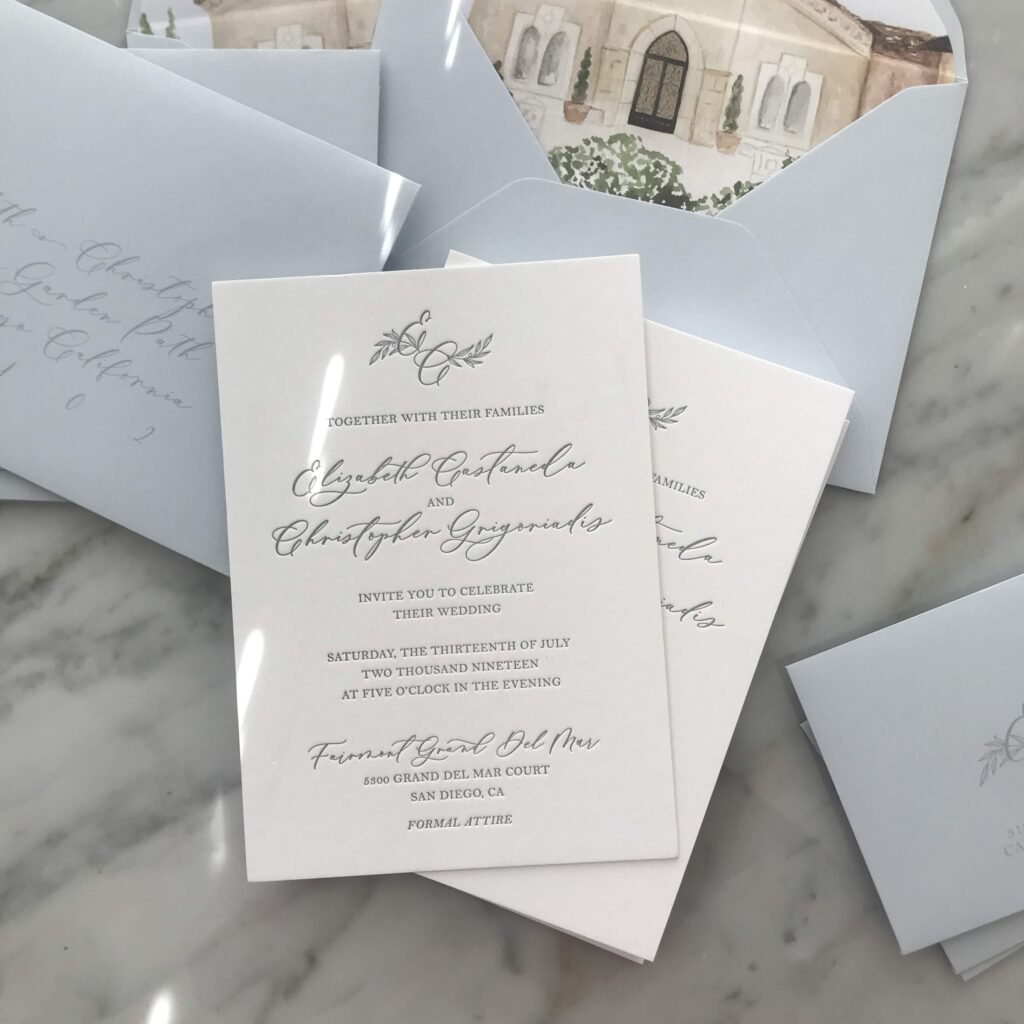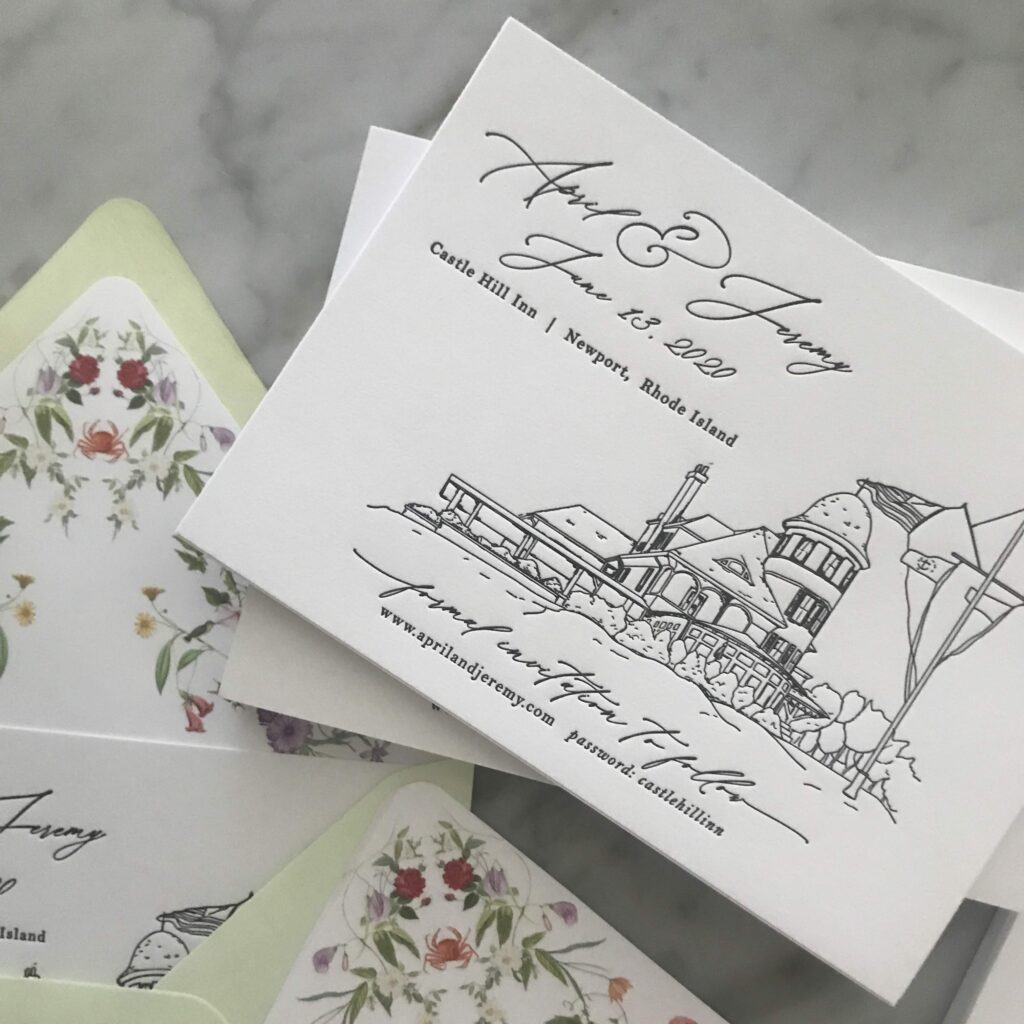Affilate Marketing
All Things Printing
Business Resources
CRMs and Systems
Marketing
Tips & Tricks
Hi, I'm Laney!
I make wedding invitations and I teach artists how to work smarter, make money, and run a business that works for you.
We'd love to have you join us - signup for our email list to get DBL updates, stationery design tricks, business tips and more!
Foil Stamping and Letterpress Printing for Wedding Invitations
Have you ever admired those gorgeous gold foil stamped invitations? What about letterpress printed invitations? Maybe you’re not sure what foil or letterpress printing for invitations even is. Let me tell you – you’re in for a treat. Today, I’ll walk you through:
- What are gold foil invitations?
- What are letterpress invitations?
- How does foil stamping and letterpress work?
- Why are foil and letterpress invitations more expensive?
- How to save money on foil and letterpress invitations
- Where to get foil and letterpress invitations
You can also check out this video that briefly gives an overview of the most common wedding invitation printing methods!
What are gold foil invitations?
Gold foil invitations are invites that have been printed with a printing technique called “gold foil stamping”. The printers will actually take a very thin sheet of foil and press it really hard with heat and pressure into the paper. This creates a beautiful indentation where the foil meets the paper. You’d be able to run your fingers over the paper and feel where it’s printed. This makes foil invites feel luxurious and special.
We often call foiled invitations “gold foil” but in truth, the foil comes in lots of colors! It’s usually a shiny metallic, but you can also get matte foils, holographic foils, and more! Gold is the most common foil color used for invitations though.
Pssst! My favorite print vendor, PrintsWell Fulfillment, now offers foil and white ink printing together!! Check out this video for how to design and order this beautiful combo!!


What are letterpress invitations?
Letterpress wedding invitations are similar to foil stamped invites, but instead of pressing a sheet of foil into the paper, letterpress printers press ink into the paper. It gives a really soft, almost vintage feel to the invites. Since you are using ink, however, you can’t use just any color. For instance, we often get asked for shiny gold letterpress invitations, and you’d need to use foil to achieve a shiny look. Think of it this way: any color you could mix in paint from the craft store, you can get in letterpress.


You can even use ombre effects on letterpress invites! The printer would put multiple colors together on the press, and blend them, for a rainbow effect.
How does foil stamping work?
Foil stamping works using a physical press vs. a machine printer. The press operator loads a roll of foil onto the press, and attaches a metal die of the desired design. Then they load paper into the press one by one, and the press heats up. It presses the metal die into the paper, with the foil sandwiched in between. The combination of pressure and heat on the press allows the foil to stick to the paper, and creates a luxurious indention of the design.
Each different color of foil requires a new metal die, and requires a separate run on the press. There is a person operating the press at all times, so it’s not quite as easy as just clicking “print” on your computer! The press operator has to adjust for the perfect indentation, the perfect levels of heat, and the perfect alignment (among many other things). This is why it’s often considered a luxury printing method!
How does letterpress printing work?
Letterpress printing, much like foil printing, involves physical presses and dies. Most of the time, the dies for letterpress are made out of polymers. The press operator has to mix a specific ink color (based on a Pantone formula), and apply it to spinning rollers on the press. The rollers apply ink to the die, and then the die to the paper. Letterpress printing creates a beautiful indent in the paper, like foil stamping, but with ink instead of a foil sheet.
You see a lot more multiple-color letterpress jobs than multiple-color foil stamping jobs. You still need a new die and a new press run for each color, though. Sometimes, you can use 2 colors to make 3 (for instance, have part of your design yellow, part of it blue, and part of it green where the blue and yellow are both printed and mix!). Letterpress inks are transparent, so they can mix to create new colors and effects.
Why are foil and letterpress invitations more expensive?
Letterpress and foil invites are more expensive than digital printing because of the printing process. In both cases, you need to have a die made for each color of your design. Someone also needs to operate the press manually, vs. just clicking “print” and letting a digital printer handle the rest. Letterpress and foil printing techniques are much more labor-intensive, and that’s why they are often more costly!



How to save money on foil and letterpress invitations
There are a few ways to save money on foil stamped and letterpress invitations! One common way is by re-using dies. If your die design just has the words “Save the Date” for instance, then it could be used by more than one couple, and a new die does not need to be purchased each time. This also works for a decorative border, as another example. Then you’d use digital printing for all the personalized information.
You can also mix and match foil and letterpress invitations with digital printing, which is more cost-effective. I often will recommend foil or letterpress printing for the main invitation and digital printing for the details and RSVP card.
Keeping your foil and letterpress designs to a single color will help you save money too! Oftentimes, printing in these techniques is more cost-effective for larger orders. It costs about the same amount to run 500 pieces through the press with one design as it does to run even a single (1) piece through the press. You have to pay for the die creation and press setup either way, so it’s often a good idea to look into these printing methods if you have a higher quantity of invitations.
Lastly, there is such a thing as “flat foil” printing. This is usually done by first laser printing your design and then applying “toner-reactive foil”. You run the design through a laminator (or similar) with a sheet of foil on it. Wherever there is toner from your printer, the foil will stick to it. However, this can bring about mixed results, and the foil doesn’t always stick 100% to the toner. There are a few companies with different methods of flat foil that are nice as well – you don’t get the indentation but these are often a cheaper option than true foil stamping.
Where to get foil and letterpress invitations
This brings us to where you can get foil and letterpress invites. There are still some companies making foil presses, but all letterpress presses are vintage at this point, so they can be harder to find! Often, the same printers who offer one of these techniques will also offer the other, as they are similar.
https://youtu.be/8cQZXUs5pwcMy favorite place to order foil stamped wedding invitations is PrintsWell Fulfillment. They offer a variety of colors in standard card sizes. If you sign up for an account with my link you can get $25 off your first order. This printer is for wholesale designers only, though. You will need to set up your own files (I have a video on setting up foil and letterpress files!) as well as be comfortable designing them.
If you are just ordering for your own wedding, Minted offers some lovely foil and letterpress options at reasonable prices. You’ll probably have the best luck looking up local letterpress or foil printers as well, or local stationery designers, who can help with the design and file setup, which are both more complicated when it comes to foil and letterpress printing.
Some of my favorite custom invitation designers who offers these services are:
- Knapp Design Co.
- Swell Press
- Soprano Studio
I hope this post helped you understand what makes letterpress printing and foil stamping so special!
Foil and Letterpress Printing for Wedding Invitations
Behind the scenes with your favorite Stationery Auntie Laney (and all the inside scoops!)
Not sure where you should start?
I gotchu
Just feeling it out?
Check out our 7 Day Invitation Design Crash Course!
Ready to Start?
Our signature beginner's course From Start to Suite is perfect for you! It's literally *everything* you'll need to get started as a stationer!
Ready to Scale?
Join Stationery School for continuing education with 100+ lessons and new ones released monthly!